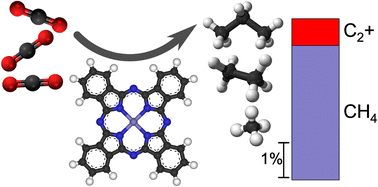Multiple C–C bond formation upon electrocatalytic reduction of CO2 by an iron-based molecular macrocycle†
Abstract
Molecular macrocycles are very promising electrocatalysts for the reduction of carbon dioxide into value-added chemicals. Up to now, most of these catalysts produced only C1 products. We report here that iron phthalocyanine, a commercially available molecule based on earth-abundant elements, can produce light hydrocarbons upon electrocatalytic reduction of CO2 in aqueous conditions and neutral pH. Under applied electrochemical potential, C1 to C4 saturated and unsaturated products are evolved. Isotopic labelling experiments unambiguously show that these products stem from CO2. Control experiments and in situ X-ray spectroscopic analysis show that the molecular catalyst remains intact during catalysis and is responsible for the reaction. On the basis of experiments with alternate substrates, a mechanism is proposed for the C–C bond formation step.

- This article is part of the themed collections: 2023 Chemical Science HOT Article Collection and Editor’s Choice: Vincent Artero


 Please wait while we load your content...
Please wait while we load your content...